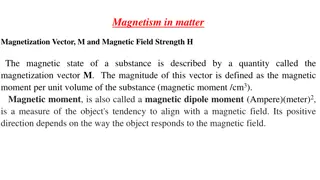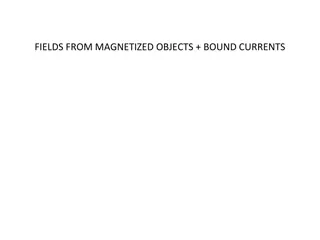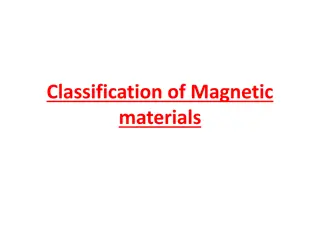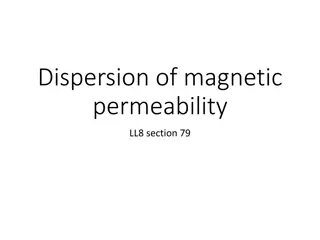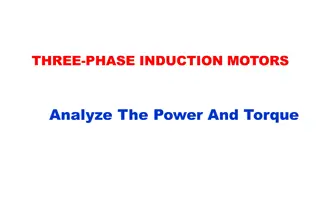Principles and Applications of Symmetry in Magnetism Summer School Lecture
This lecture delves into the principles and applications of symmetry in magnetism, covering topics such as the symmetry of response tensors, transformations of tensors, time-reversal symmetry, and beyond point groups. It explores the symmetry of local effects, equivalent magnetic configurations, exp
4 views • 14 slides
Energy Loss Due to Hysteresis in Magnetic Materials
In the realm of magnetism, magnetic materials exhibit unique behavior even when not magnetized. Ewing's theory sheds light on the alignment of molecular magnets in relation to an applied magnetizing field, resulting in energy consumption. This leads to hysteresis loss, where energy is dissipated as
4 views • 8 slides
Magnetism in Matter: Magnetization and Magnetic Field Strength
The magnetic state of a substance is characterized by the magnetization vector M, representing the magnetic moment per unit volume. The total magnetic field induction at a point within a substance depends on the applied field and magnetization M. Substances can be classified as paramagnetic, ferroma
6 views • 11 slides
Evolution of Geomagnetic Methods in Applied Geophysics and Their Diverse Applications
Explore the rich history of geomagnetic methods from ancient Chinese lodestone use to modern magnetic surveying technologies. Learn about the principles of magnetics surveying, applications in locating metal objects, mapping near-surface features, mineral exploration, and geological bedrock mapping.
14 views • 36 slides
Magnetization, Decay, and Error Fields in HTS Accelerator Magnets
The research conducted at The Ohio State University focuses on understanding the magnetization, decay, and influence of error fields in high-temperature superconducting (HTS) accelerator magnets. The study explores the impact of different superconducting materials such as Nb3Sn, YBCO, and Bi:2212 on
2 views • 21 slides
Understand Magnetic Fields and Currents in Solids
Explore the concepts of magnetic fields and currents in solids, including the calculation of magnetic dipole moments, the presence of bound currents in cylinders with uniform magnetization, the distribution of bound currents on different surfaces, and the behavior of magnetic fields in solid cylinde
3 views • 14 slides
Magnetic Particle Testing in Industry
Magnetic Particle Testing (MT) is a non-destructive method used to detect discontinuities in ferromagnetic materials by applying finely divided magnetic particles. This method, popular in industries like automotive, aerospace, and petrochemical, involves magnetization of the material, application of
3 views • 25 slides
The Classification of Magnetic Materials
The origin of magnetism lies in the orbital and spin motions of electrons, determining the magnetic properties of different materials. All matter is magnetic to some extent, with substances exhibiting diamagnetism, paramagnetism, or ferromagnetism. Diamagnetic materials oppose applied magnetic field
3 views • 24 slides
Magnetic Permeability and Electrodynamics in Macroscopic Systems
Exploring the dispersion of magnetic permeability, permittivity, and magnetization in different frequency ranges. Discussing conditions for neglecting certain parameters and the impact of electromagnetic waves on small body dimensions. Highlighting the importance of magnetization in macroscopic elec
0 views • 20 slides
Exploring Magnetic Properties of Matter
This content delves into the magnetic properties of matter, covering topics such as permanent magnets, magnetization of objects, current flow in conductors, and the origin of magnetic fields. It explores the concepts of magnetic fields created by moving charges, the role of electrons in generating m
4 views • 19 slides
Thermodynamic Properties of Magnetic Substances
Delve into the thermodynamic potential, free energy, and magnetization of magnetic substances in relation to electric and magnetic fields, exploring the intricacies of irreversible processes, work done, and energy densities.
0 views • 14 slides
Explore Electromagnetism and Magnetization Techniques
Discover the fascinating world of electromagnetism and magnetization through a series of practical experiments and demonstrations. Learn how to create electromagnets using everyday materials, differentiate between electromagnets and inductors, figure out polarity using compasses, make permanent magn
0 views • 10 slides
Analysis of Three-Phase Induction Motors: Power and Torque Insights
Explore the development of the equivalent circuit for three-phase induction motors, illustrating the interplay between stator and rotor windings, magnetization curves, and impedance considerations. Understand the transformer-like operation and the requirements for magnetizing current and flux level
2 views • 15 slides
T1 Relaxation in MRI Imaging
Learn about T1 relaxation in MRI imaging, where the perturbed system returns to equilibrium. Discover the significance of T1 relaxation time, magnetization recovery, and the process of spins aligning with the Z-axis post-RF pulse. Dive into the details of how the net magnetization regrows along the
1 views • 21 slides
Dynamic Magnetic Behavior Study in Exchange-Coupled IrMn/NiFe System
Explore the re-entrant antiferromagnetism in the exchange-coupled IrMn/NiFe system. Investigate the magnetic properties, exchange coupling mechanism, and hysteresis loops in the NiFe/IrMn film. Understand the magnetization reversal and effects of exchange magnetic anisotropy. Discover insights into
0 views • 17 slides
Understanding Magnetic Fields in Cylinders
Explore the behavior of magnetic fields in solid cylinders with uniform magnetization, identifying the direction of bound currents and magnetic dipole moments. Discussions cover scenarios with magnetization in different directions and variations in cylinder shapes. Additionally, discover the implica
3 views • 14 slides


